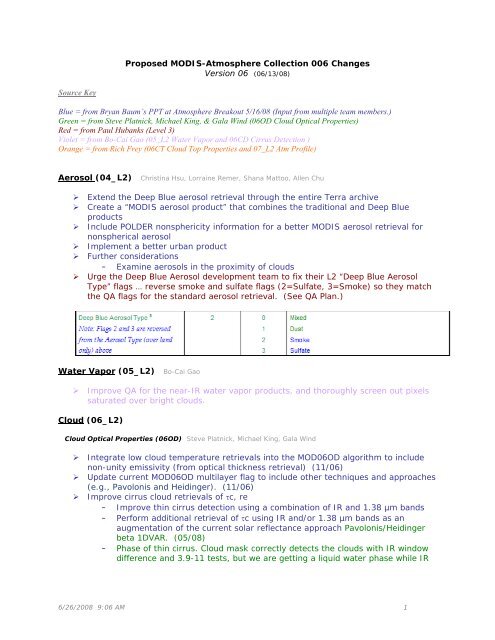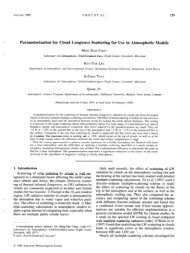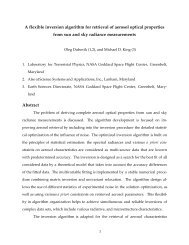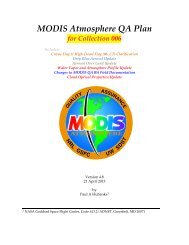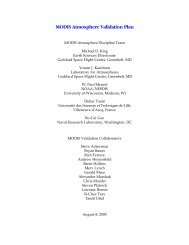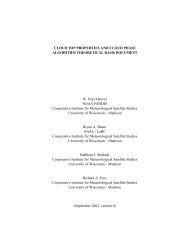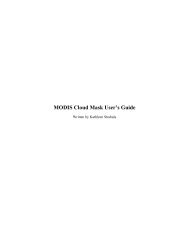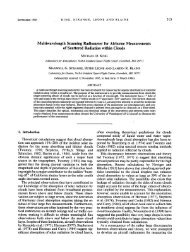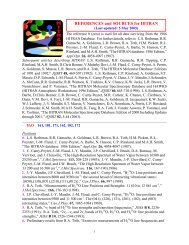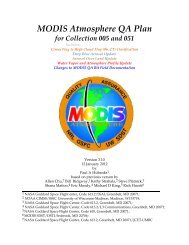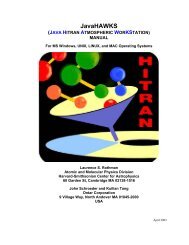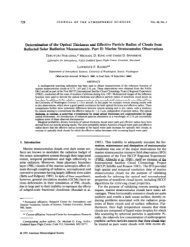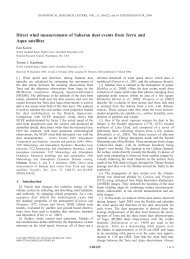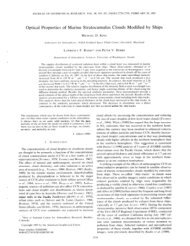Collection_006_Chang.. - MODIS Atmosphere
Collection_006_Chang.. - MODIS Atmosphere
Collection_006_Chang.. - MODIS Atmosphere
You also want an ePaper? Increase the reach of your titles
YUMPU automatically turns print PDFs into web optimized ePapers that Google loves.
Source Key<br />
Proposed <strong>MODIS</strong>-<strong>Atmosphere</strong> <strong>Collection</strong> <strong>006</strong> <strong>Chang</strong>es<br />
Version 06 (06/13/08)<br />
Blue = from Bryan Baum’s PPT at <strong>Atmosphere</strong> Breakout 5/16/08 (Input from multiple team members.)<br />
Green = from Steve Platnick, Michael King, & Gala Wind (06OD Cloud Optical Properties)<br />
Red = from Paul Hubanks (Level 3)<br />
Violet = from Bo-Cai Gao (05_L2 Water Vapor and 06CD Cirrus Detection )<br />
Orange = from Rich Frey (06CT Cloud Top Properties and 07_L2 Atm Profile)<br />
Aerosol (04_L2) Christina Hsu, Lorraine Remer, Shana Mattoo, Allen Chu<br />
Extend the Deep Blue aerosol retrieval through the entire Terra archive<br />
Create a “<strong>MODIS</strong> aerosol product” that combines the traditional and Deep Blue<br />
products<br />
Include POLDER nonsphericity information for a better <strong>MODIS</strong> aerosol retrieval for<br />
nonspherical aerosol<br />
Implement a better urban product<br />
Further considerations<br />
– Examine aerosols in the proximity of clouds<br />
Urge the Deep Blue Aerosol development team to fix their L2 “Deep Blue Aerosol<br />
Type” flags … reverse smoke and sulfate flags (2=Sulfate, 3=Smoke) so they match<br />
the QA flags for the standard aerosol retrieval. (See QA Plan.)<br />
Water Vapor (05_L2) Bo-Cai Gao<br />
Improve QA for the near-IR water vapor products, and thoroughly screen out pixels<br />
saturated over bright clouds.<br />
Cloud (06_L2)<br />
Cloud Optical Properties (06OD) Steve Platnick, Michael King, Gala Wind<br />
Integrate low cloud temperature retrievals into the MOD06OD algorithm to include<br />
non-unity emissivity (from optical thickness retrieval) (11/06)<br />
Update current MOD06OD multilayer flag to include other techniques and approaches<br />
(e.g., Pavolonis and Heidinger). (11/06)<br />
Improve cirrus cloud retrievals of τc, re<br />
– Improve thin cirrus detection using a combination of IR and 1.38 µm bands<br />
– Perform additional retrieval of τc using IR and/or 1.38 µm bands as an<br />
augmentation of the current solar reflectance approach Pavolonis/Heidinger<br />
beta 1DVAR. (05/08)<br />
– Phase of thin cirrus. Cloud mask correctly detects the clouds with IR window<br />
difference and 3.9-11 tests, but we are getting a liquid water phase while IR<br />
6/26/2008 9:06 AM 1
is undetermined. Clearly, if the mask can detect the cirrus then we ought to<br />
use those mask tests to help in the phase logic. (04/07)<br />
* [removed from STM notes] CSR. According to Gala Wind, the default for 250 m tests is to set<br />
all of the 250 m pixels to clear, and then change to cloud upon reading such as result from cloud<br />
mask. But the logic should be reversed, i.e., all 250 m pixels are set to cloudy and then changed<br />
to clear upon reading such a result from the cloud mask. Either approach is irrelevant unless<br />
there are missing 250 m L1B pixels. This is the likely reason why CSR was showing thick ice<br />
cloud striping due to the faulty QA in the Jan. 2007 L1B LUT delivery. The old/original LUT was<br />
then used to reprocess data so isn’t a cause of immediate widespread concern but this is an<br />
error in the logic.<br />
Modify table look-up libraries and solution algorithm<br />
– Add more small τc in libraries to reduce interpolation errors for thin clouds<br />
– Remove asymptotic algorithm for thick clouds, replacing it with more τc<br />
libraries; no impact on solutions but simplifying algorithm maintenance<br />
– Include ocean BRDF to accommodate, especially, thin cloud retrievals over<br />
ocean<br />
Partly cloudy pixels<br />
– Better use of 250 m cloud mask (at least over ocean) for QA of MOD06OD<br />
and CT retrievals (11/06)<br />
– Coakley-type spatial variance vs. temperature approach (Note: Rich Frey<br />
doesn’t think the Coakley algorithm should be included in this list. However,<br />
he could see calculating a variance statistic of some kind using band 2 and<br />
including a flag in the L2 output that indicates a non-uniform scene. I think<br />
the cloud team should discuss this more before we commit to anything.)<br />
Either provide scaled optical thickness in the data set AND/OR include a vector of ice<br />
cloud g and ssa in the data set, so: (1) users could scale optical thickness from our<br />
retrievals to their own library of g values in non-absorbing bands, and g & ssa for<br />
absorbing bands (e.g., a broadband code in a climate model). (2) users could scale<br />
our effective radius to their own library of re by scaling ssa. (03/08)<br />
Despite tradition, we don’t believe that delta transmittance should be included in ice<br />
cloud radiative transfer calculations. For <strong>MODIS</strong> C5, eliminating delta transmittance<br />
reduces g for re>10 µm and reduces the slope of g vs. re. This mitigates some of the<br />
need for roughened particles. (05/08)<br />
Pursue Aqua cold focal plane adjustment in L1B production. Jack Xiong says Vermote<br />
has done something along these lines. (05/08)<br />
Cloud Top Properties (06CT) Rich Frey, Kathy Strabela, Paul Menzel<br />
Implement “top-down” method of final cloud top pressure choice for Aqua<br />
Avoid CO2 slicing solutions in water clouds and IRW solutions in ice or mixed phase<br />
clouds<br />
Output cloud (geopotential) heights along with cloud top pressures<br />
Run algorithm at 1 km resolution<br />
Include cloud overlap / phase at 1 km<br />
Include multiple cloud top pressure solution flag for window channel retrievals<br />
Investigate inversion detection for low level water cloud to be located below<br />
inversion<br />
– Survey globe to see frequency of occurrence of low level inversions in GDAS<br />
dataset used as ancillary information<br />
Are these correctly found over ocean, land, and coastlines?<br />
Are they found at the correct height, when present?<br />
This initial work has already been done. The use of GDAS to identify<br />
inversions is not perfect, but leads to much improvement in L2 output in<br />
marine stratus cloud regimes. I would simply include one bullet that states:<br />
6/26/2008 9:06 AM 2
GDAS temperature profile data will be used to identify regions where<br />
temperature inversions exist and an alternative IRW method will be<br />
implemented.<br />
Cirrus Detection (06CD) Bo-Cai Gao<br />
Improve cirrus reflectance retrievals over dry high elevation areas, such Tibet<br />
Plateau, Andes Mountains, Antarctic and Greenland. The collection 05 cirrus<br />
reflectance products over these areas are slightly contaminated by surface reflection<br />
effects.<br />
Atmospheric Profile (07_L2) Eva Borbas, Suzanne Seemann, Rich Frey<br />
Update surface emissivity data base to current version<br />
Investigate the dry bias in Aqua TPW and make adjustments to improve.<br />
Perform a more thorough evaluation of the ozone product through intercomparisons<br />
with TOMS and AIRS and make adjustments to algorithm<br />
Evaluate the current radiance bias adjustments in Aqua and Terra algorithms and<br />
make updates.<br />
Look into whether we can include all profiles at 101 levels in direct broadcast or at<br />
the DAAC, and an ozone profile instead of just TOZ.<br />
Assess the TPW Low and TPW High products and possibly change the levels of<br />
integration to make them more useful.<br />
Improve QA/QC flags and screening for bad input MOD02L1B data.<br />
Examine the MOD07 Level 3 products for consistency with other long term datasets<br />
(NVAP).<br />
Perform an experimental combined retrieval with AIRS, for at least a few cases.<br />
Making Aqua and Terra DAAC code uniform<br />
Have the <strong>Atmosphere</strong> Profile development team fix (remove the noise in fill regions)<br />
all 07_L2 <strong>Atmosphere</strong> Profile Usefulness and Confidence QA Flags. This problem<br />
might stem from the QA flags not being initialized as 0’s; but this is unclear.<br />
Cloud Mask (35_L2) Rich Frey, Steven Ackerman<br />
Implement angle-dependent 0.86 μm thresholds for day ocean<br />
Implement day/night, land/water dust detection algorithm<br />
Lower 1.38 μm thresholds to “thin cirrus” values, but keep thin cirrus flag for users<br />
(all scene types except snow/ice)<br />
6/26/2008 9:06 AM 3
Investigate cloud test using variability of 0.86 μm reluctances in a 3x3 region for day<br />
ocean<br />
Investigate angle and location-dependent 0.66 μm thresholds for day land<br />
Investigate cloud test using variability of 3.75 μm BTs for night ocean<br />
Investigate use of 7.2-11 μm BTDs in polar day scenes<br />
Use 11 μm BTs and surface data to help screen out false snow from both maps<br />
(night) and NDSI (day)<br />
Tune-ups:<br />
– 3.9-11 μm cloud test threshold/algorithm for night coastlines and shallow<br />
water (eliminate uncertain results as much as possible)<br />
– 3.9-11 μm cloud test thresholds for night land in moist environments (e.g.,<br />
Amazon)<br />
– Adjust Antarctic night cloud test thresholds<br />
Joint <strong>Atmosphere</strong> (ATML2) Paul Hubanks<br />
Check with all L2 development teams to ensure any changes to L2 HDF files (new<br />
parameters, new or changed QA, etc.) are accounted for in the Joint L2.<br />
Level-3 Gridded Product (08_D3, 08_E3, 08_M3) Paul Hubanks<br />
Add joint histogram of cloud optical thickness and cloud top pressure for combined<br />
phase to more easily compare with ISCCP joint histogram<br />
Add smoke only, dust only, and sulfate only aggregations of Deep Blue aerosol.<br />
Aggregate aerosol single scattering albedo for dust from Deep Blue algorithm. Make<br />
sure to sync any L2 Deep Blue Aerosol Type flag change to L3.<br />
Modify Cloud Effective Radius (Re) liquid water cloud histograms and joint<br />
histograms to start at 4.0. In addition, use the newly defined Research L3<br />
boundaries for Cloud Effective Radius (Re) joint histograms<br />
New Bin Bounds for C<strong>006</strong> = 4, 6, 8, 10, 12, 14, 16, 18, 20, 25, 30<br />
Old Bin Bounds for C005 = 2, 4, 6, 8, 10, 12.5, 15, 17.5, 20, 25, 30<br />
Increase number of bins in the marginal histograms (especially for ice cloud effective<br />
radius). Check all the Research L3 histogram bin bounds against the Operational L3<br />
(change the Operational L3 where appropriate). Increase # of bins and reduce<br />
histogram bin sizes for Re Ice esp in the 20 to 32 range but perhaps along entire<br />
range.<br />
Add Cloud Top Height parameter to L3. Add new marginal histograms for this SDS<br />
(develop a most useful definition of histogram bin boundaries). Q: Are new joint<br />
histograms based on this parameter envisioned?<br />
Modify L3 code to compute median. Add median statistics to some parameters of L3.<br />
(esp Cloud Optical Property parameters)<br />
Fix File Spec “long name” for Cloud Fraction Histogram Counts (delete at 10<br />
intervals)<br />
Use uncertainty to develop new QA-weighted means of Cloud Optical Property<br />
parameters. (check with S.Platnick)<br />
Check with all L2 development teams to ensure any changes to L2 HDF files (new<br />
parameters, new or changed QA, etc.) are accounted for in the L3 (sync the L3 to<br />
L2)<br />
Investigate a clean up of the Mean_Reflectance_Land_All parameter (using QA for 47<br />
and QA for 66)<br />
6/26/2008 9:06 AM 4
Investigate if the Standard Deviation of the Daily Means should be weighted in the<br />
multiday product (and if so, how should this be done and what does this mean).<br />
This statistic is currently weighted by D3 pixel counts, but I am unsure if this is<br />
actually correct. The statistic could be more intuitive if this was unweighted.<br />
Determine if the Aerosol group wants to add any of their new SDS’s into L3.<br />
6/26/2008 9:06 AM 5


